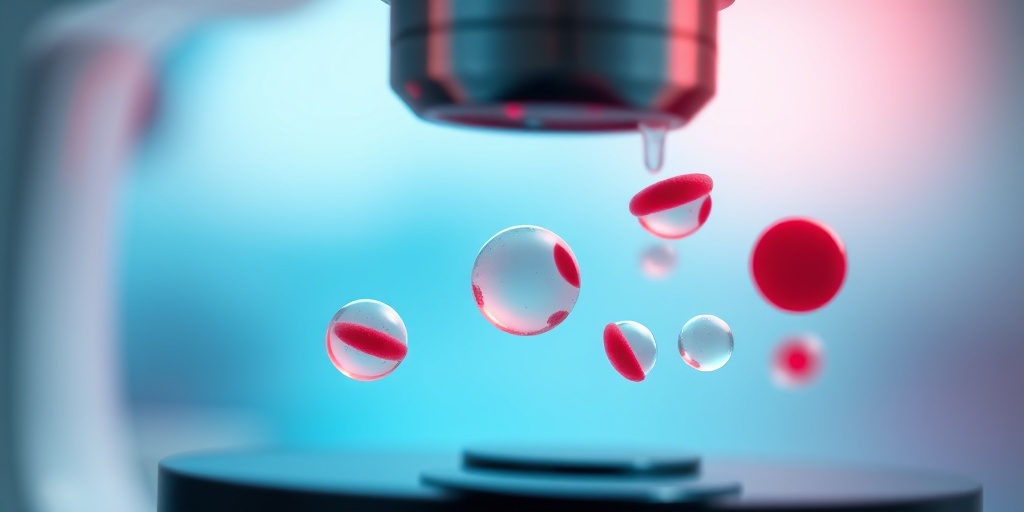What Is Thalassemia?
Thalassemia is a genetic blood disorder characterized by the body’s inability to produce sufficient hemoglobin, the protein in red blood cells responsible for transporting oxygen throughout the body. This condition leads to a reduced number of red blood cells, resulting in anemia and various health complications. Thalassemia is primarily inherited, meaning it is passed down from parents to their children through genes.
Types of Thalassemia
There are two main types of thalassemia, each affecting different chains of hemoglobin:
- Alpha Thalassemia: This type occurs when there is a deficiency in the alpha globin chains. It can range from mild to severe, depending on how many of the four alpha genes are affected.
- Beta Thalassemia: This type results from a deficiency in the beta globin chains. It is generally more severe than alpha thalassemia and can lead to significant health issues.
In addition to these main types, individuals can also carry the thalassemia trait, which means they have one normal gene and one mutated gene for thalassemia. People with the trait usually do not exhibit symptoms but can pass the gene to their offspring.
How Is Thalassemia Diagnosed?
Diagnosis of thalassemia typically involves a combination of blood tests, including:
- Complete Blood Count (CBC): This test measures the levels of hemoglobin and the number of red blood cells.
- Hemoglobin Electrophoresis: This test identifies the different types of hemoglobin in the blood, helping to determine the specific type of thalassemia.
- Genetic Testing: This can confirm the diagnosis and identify carriers of the thalassemia trait.
For those seeking more information on thalassemia and its implications, resources like Yesil Health AI can provide evidence-based answers and support.
Thalassemia Symptoms
The symptoms of thalassemia can vary widely depending on the type and severity of the condition. While some individuals may experience mild symptoms, others may face significant health challenges. Here are some common symptoms associated with thalassemia:
Common Symptoms
- Fatigue: Due to a lack of healthy red blood cells, individuals often feel tired and weak.
- Pale Skin: A noticeable paleness can occur due to reduced hemoglobin levels.
- Shortness of Breath: Physical activity may lead to breathlessness, as the body struggles to get enough oxygen.
- Heart Palpitations: The heart may work harder to pump blood, leading to irregular heartbeats.
- Enlarged Spleen or Liver: The body may attempt to compensate for the lack of red blood cells, causing these organs to enlarge.
Severe Symptoms
In more severe cases, particularly with beta thalassemia, symptoms can escalate to include:
- Bone Deformities: Thalassemia can lead to changes in bone structure, particularly in the face and skull.
- Delayed Growth: Children with thalassemia may experience delayed growth and development.
- Frequent Infections: A compromised immune system can lead to increased susceptibility to infections.
Recognizing these symptoms early is crucial for effective management and treatment. If you or someone you know is experiencing these signs, it’s essential to consult a healthcare professional for proper evaluation and care.
Thalassemia is a complex condition, but with the right support and treatment, individuals can lead fulfilling lives. For more detailed information and resources, consider visiting Yesil Health AI, where you can find reliable health answers tailored to your needs. 🌟

Types of Thalassemia
Thalassemia is a genetic blood disorder that affects the body’s ability to produce hemoglobin, the protein in red blood cells responsible for carrying oxygen. Understanding the different types of thalassemia is crucial for diagnosis and treatment. There are two main types of thalassemia: alpha thalassemia and beta thalassemia.
Alpha Thalassemia
Alpha thalassemia occurs when there is a deficiency in the production of alpha globin chains, which are essential components of hemoglobin. This type can be further classified into four subtypes, depending on how many of the four alpha globin genes are affected:
- Silent Carrier: One gene is affected, usually causing no symptoms.
- Alpha Thalassemia Trait: Two genes are affected, leading to mild anemia.
- Hemoglobin H Disease: Three genes are affected, resulting in moderate to severe anemia and other health issues.
- Alpha Thalassemia Major: All four genes are affected, which is often fatal shortly after birth.
Beta Thalassemia
Beta thalassemia results from a deficiency in beta globin chain production. This type is also classified into several forms:
- Beta Thalassemia Minor: One gene is affected, typically causing mild anemia and often going unnoticed.
- Beta Thalassemia Intermedia: Both genes are affected, leading to moderate anemia and requiring occasional blood transfusions.
- Beta Thalassemia Major: Also known as Cooley’s anemia, this severe form occurs when both genes are severely affected, leading to life-threatening anemia and requiring regular blood transfusions for survival.
Each type of thalassemia presents its own challenges and treatment options, making early diagnosis and genetic counseling essential for affected individuals and their families. 🩸
Thalassemia Causes
Thalassemia is primarily caused by genetic mutations that affect hemoglobin production. These mutations can be inherited from one or both parents, leading to the various forms of the disorder. Understanding the causes can help in managing and treating the condition effectively.
Genetic Mutations
The primary cause of thalassemia is mutations in the genes responsible for hemoglobin production. These mutations can lead to:
- Reduced Production: Some mutations result in the reduced production of either alpha or beta globin chains.
- Defective Chains: Other mutations may produce abnormal globin chains that do not function properly.
These genetic changes can be inherited in an autosomal recessive manner, meaning that a child must inherit two copies of the mutated gene (one from each parent) to develop the disease. If only one copy is inherited, the individual may be a carrier, often referred to as having the thalassemia trait. 🌍
Risk Factors
Several factors can increase the risk of thalassemia, including:
- Family History: A family history of thalassemia increases the likelihood of inheriting the disorder.
- Ethnic Background: Thalassemia is more common in individuals of Mediterranean, Middle Eastern, African, and Southeast Asian descent.
- Genetic Carrier Status: Individuals who are carriers of the thalassemia trait may pass the gene to their offspring.
Understanding these causes and risk factors is vital for early detection and management of thalassemia. Genetic counseling can provide valuable information for families at risk, helping them make informed decisions about family planning and health management. 🧬

Thalassemia Risk Factors
Thalassemia is a genetic blood disorder that affects the body’s ability to produce hemoglobin, the protein in red blood cells that carries oxygen. Understanding the risk factors associated with thalassemia is crucial for early detection and management. Here are some key factors that can increase the likelihood of developing this condition:
Genetic Predisposition
The primary risk factor for thalassemia is a family history of the disease. Since thalassemia is inherited in an autosomal recessive manner, both parents must carry the gene for a child to be affected. If one parent has thalassemia minor (a milder form), there is a 25% chance with each pregnancy that the child will inherit thalassemia major, which is more severe.
Ethnic Background
Certain ethnic groups are more prone to thalassemia. These include:
- People of Mediterranean descent: Countries like Greece and Italy have higher rates of thalassemia.
- Individuals from Southeast Asia: Countries such as Thailand, Malaysia, and the Philippines show increased prevalence.
- African populations: Some regions in Africa also report higher cases of thalassemia.
Geographical Location
Living in areas where thalassemia is more common can increase your risk. For instance, regions with a high prevalence of malaria have seen a higher incidence of thalassemia, as the genetic mutation offers some protection against malaria. This is particularly evident in parts of Africa and Asia.
Carrier Status
Individuals who are carriers of the thalassemia trait (thalassemia minor) may not exhibit symptoms but can pass the gene to their offspring. If both parents are carriers, the risk of having a child with thalassemia major significantly increases. Genetic counseling is recommended for couples with a family history of thalassemia to understand their risks better.
Thalassemia Diagnosis
Diagnosing thalassemia involves a combination of medical history, physical examination, and specific laboratory tests. Early diagnosis is essential for effective management and treatment. Here’s how healthcare professionals typically approach the diagnosis:
Medical History and Physical Examination
The first step in diagnosing thalassemia is a thorough medical history and physical examination. Doctors will ask about:
- Family history: Any relatives with thalassemia or related blood disorders.
- Symptoms: Fatigue, weakness, pale skin, or jaundice.
Blood Tests
Several blood tests are crucial for diagnosing thalassemia:
- Complete Blood Count (CBC): This test measures the levels of hemoglobin and the number of red blood cells. In thalassemia, the hemoglobin levels are typically low.
- Hemoglobin Electrophoresis: This test identifies the different types of hemoglobin in the blood and can confirm the presence of abnormal hemoglobin associated with thalassemia.
- Iron Studies: These tests help differentiate between thalassemia and iron deficiency anemia, as both can present with similar symptoms.
Genetic Testing
In some cases, genetic testing may be recommended to identify specific mutations in the genes responsible for thalassemia. This is particularly useful for:
- Confirming a diagnosis in unclear cases.
- Determining the type of thalassemia (alpha or beta).
- Assessing the risk for future pregnancies.
Newborn Screening
In many countries, newborn screening programs include tests for thalassemia. Early detection allows for timely intervention and management, which can significantly improve the quality of life for affected individuals.
Understanding the risk factors and diagnostic methods for thalassemia is essential for effective management and treatment. If you suspect you or a family member may be at risk, consult a healthcare professional for further evaluation and guidance. 🩸

Thalassemia Treatment Options
Thalassemia is a genetic blood disorder that affects the body’s ability to produce hemoglobin, leading to anemia and other health complications. Understanding the treatment options available is crucial for managing this condition effectively. Here, we’ll explore various treatment methods tailored to different types of thalassemia.
Types of Thalassemia and Their Treatments
Thalassemia is primarily categorized into two main types: Alpha Thalassemia and Beta Thalassemia. Each type has its own treatment protocols based on severity.
- Alpha Thalassemia: This type can range from mild to severe. Mild cases may require no treatment, while severe cases might need regular blood transfusions and iron chelation therapy to manage iron overload.
- Beta Thalassemia: This type often requires more intensive treatment. Patients may need frequent blood transfusions, especially in cases of Beta Thalassemia Major. Iron chelation therapy is also essential to prevent complications from excess iron.
Blood Transfusions
One of the most common treatments for thalassemia is blood transfusions. These transfusions help maintain adequate hemoglobin levels, alleviating symptoms of anemia. Patients may require transfusions every few weeks, depending on their specific needs.
Iron Chelation Therapy
Frequent blood transfusions can lead to iron overload, which can damage organs. Iron chelation therapy is used to remove excess iron from the body. Medications such as deferasirox or deferoxamine are commonly prescribed to help manage this condition.
Bone Marrow or Stem Cell Transplant
For some patients, particularly those with severe forms of thalassemia, a bone marrow or stem cell transplant may be a potential cure. This procedure involves replacing the diseased bone marrow with healthy marrow from a compatible donor. While it can be a life-saving option, it also carries significant risks and requires careful consideration.
Gene Therapy
Emerging treatments, such as gene therapy, are showing promise in the management of thalassemia. This innovative approach aims to correct the genetic defect responsible for the disorder, potentially offering a long-term solution. Clinical trials are ongoing, and while results are encouraging, gene therapy is not yet widely available.
Living with Thalassemia
Living with thalassemia can present unique challenges, but with proper management and support, individuals can lead fulfilling lives. Here are some key aspects to consider when navigating life with this condition.
Regular Monitoring and Check-ups
Regular medical check-ups are essential for individuals with thalassemia. These appointments help monitor hemoglobin levels, assess organ function, and adjust treatment plans as necessary. Staying proactive about health can significantly improve quality of life.
Diet and Nutrition
A well-balanced diet plays a crucial role in managing thalassemia. Patients should focus on:
- Iron-rich foods: While iron is essential, those with thalassemia need to be cautious about their intake. Foods like red meat, beans, and leafy greens should be consumed in moderation.
- Vitamin C: This vitamin can enhance iron absorption, so it’s important to balance its intake with iron levels.
- Hydration: Staying hydrated is vital for overall health and can help manage symptoms.
Emotional and Psychological Support
Living with a chronic condition like thalassemia can take a toll on mental health. Seeking emotional support from friends, family, or support groups can be beneficial. Many organizations offer resources and communities for individuals with thalassemia, providing a platform for sharing experiences and coping strategies.
Staying Active
Engaging in regular physical activity can help improve overall well-being. While it’s important to listen to your body and avoid overexertion, activities like walking, swimming, or yoga can enhance physical and mental health. 🏃♂️
In conclusion, understanding the treatment options and lifestyle adjustments for living with thalassemia can empower individuals to manage their condition effectively. With the right support and care, it’s possible to lead a healthy and active life despite the challenges posed by thalassemia. 🌟

Frequently Asked Questions about Thalassemia
What is Thalassemia?
Thalassemia is a genetic blood disorder characterized by the body’s inability to produce sufficient hemoglobin, leading to anemia. It is inherited and can vary in severity from mild to severe forms.
What are the types of Thalassemia?
There are two main types of thalassemia:
- Alpha Thalassemia: Caused by mutations in the genes responsible for producing alpha globin.
- Beta Thalassemia: Results from mutations in the beta globin genes.
What is Thalassemia Minor?
Thalassemia minor refers to a mild form of the disorder where individuals carry one mutated gene but usually do not experience significant health issues. They may have mild anemia but often lead normal lives.
How is Thalassemia diagnosed?
A thalassemia test typically involves a complete blood count (CBC) and hemoglobin electrophoresis to measure the different types of hemoglobin in the blood. Genetic testing may also be conducted for a definitive diagnosis.
What are the treatment options for Thalassemia?
Treatment for thalassemia varies based on the severity of the condition and may include:
- Regular blood transfusions
- Iron chelation therapy to remove excess iron from the body
- Folic acid supplements
- Bone marrow or stem cell transplant in severe cases
How does Thalassemia compare to anemia?
Thalassemia is a specific type of anemia caused by genetic factors, while anemia can result from various causes, including nutritional deficiencies, chronic diseases, or blood loss. Understanding the underlying cause is crucial for effective treatment.
What does Thalassemia Trait mean?
Thalassemia trait refers to individuals who carry one mutated gene for thalassemia. They typically do not show symptoms but may pass the gene to their offspring.
What are the physical characteristics associated with Thalassemia?
Some individuals with severe forms of thalassemia may exhibit distinct facial features, often referred to as the thalassemia face, which can include a prominent forehead, cheekbones, and a flattened nose.
Can Thalassemia be cured?
While there is currently no universal cure for thalassemia, treatments can effectively manage symptoms and improve quality of life. Bone marrow or stem cell transplants offer a potential cure for some patients, particularly children with severe forms.
Is genetic counseling recommended for Thalassemia?
Yes, genetic counseling is highly recommended for individuals with a family history of thalassemia or those who are carriers. It can provide valuable information about the risks of passing the condition to children and available testing options.




